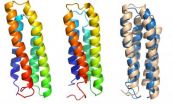(Press-News.org) HOUSTON – (July 16, 2014) – Rice University scientists have succeeded in analyzing transmembrane protein folding in the same way they study the proteins' free-floating, globular cousins.
Rice theoretical biologist Peter Wolynes and his team at the university's Center for Theoretical Biological Physics (CTBP) have applied his energy landscape theory to proteins that are hard to view because they live and work primarily inside cell membranes.
The method should increase the technique's value to researchers who study proteins implicated in diseases and possibly in the creation of drugs to treat them, he said.
The study appeared this week in the Proceedings of the National Academy of Sciences. Lead author Bobby Kim, a graduate student, and co-author Nicholas Schafer, a postdoctoral research associate, are both members of Wolynes' Rice lab.
Membrane proteins are critical to such functions as photosynthesis and vision, among many others. They can also serve as a cell's gatekeepers by deciding what may pass through, and also as its gates by helping transport nourishment from the outside and waste from the inside. Because of these multiple roles, they constitute a large percentage of drug targets.
While their function is clear, information about how they fold lags far behind what is available for globular proteins, Wolynes said. "This is strange because membrane proteins are about 30 percent of the genome," he said.
Wolynes and his colleagues use raw genomic information to predict how strands of amino acids will fold into functional proteins by following paths of least resistance (aka the principle of minimal frustration) dictated by the energy associated with each "bead" in the strand. The closer a protein gets to its functional "native" state, the more stable it becomes. Wolynes' pioneering theory graphically represents this energy as a funnel.
The researchers test their computer models by comparing them to the structures of actual proteins acquired through X-ray crystallography. Plenty of structures are available for globular folded proteins, which float around the body to carry out tasks essential to life.
But until recent years, similar structures for transmembrane proteins have been hard to come by because of the difficulty of isolating them for imaging without destroying them. Recent advances use a detergent to wash most of the membrane away from a protein of interest, Wolynes said. "It leaves a fatty layer around the protein but nevertheless gives a sort of coating that allows the whole molecule to form a crystal lattice later on," he said.
Wolynes was inspired to study membrane proteins when he noticed that two widely used cell biology textbooks were in complete disagreement about how they folded.
"One of them, after listing all the rules, said, 'This is evidence that it's kinetically controlled.' The other said, 'This is evidence that it's equilibrium-controlled.' They're written in that way of introductory textbooks where anything they tell you about, they act as if it's absolutely certain. And they were in direct opposition.
"I would say I'm still not certain, but I think our work points much more in the direction that folding is thermodynamically (equilibrium) controlled, at least once the protein is stuck in the membrane."
Kim and Schafer modified a protein-folding algorithm used by the Wolynes lab called the Associative Memory, Water-Mediated, Structure and Energy Model (AWSEM) to account for outside influences unique to membrane proteins, including the translocon mechanism that inserts partially folded proteins into a membrane, and the membrane itself.
With the algorithm, they successfully determined that thermodynamic funnels still seem to hold the upper hand in folding proteins inside a membrane, as they do for globular proteins.
"We had a database of membrane protein structures from many different labs and we were able to learn the parameters that were transferable between them," Kim said. "These parameters specify how strongly two residues (the "beads") should interact and take into account the surrounding environment. That allowed us to make predictions from the raw sequences."
The researchers expect to fine-tune the AWSEM-membrane algorithm as more structures become available. "I don't think we're done learning about membrane interactions," Wolynes said, suggesting that much of the funneled folding happens after the protein enters the membrane and that very little of it is due to the hydrophobic (kinetic) interactions that play a somewhat larger role in globular protein folding. "My gut feeling is that's going to be right," he said.
"The significance of the paper is that we now have an algorithm to predict membrane protein structure pretty well based on the raw genome sequence," Wolynes said. "This is going to be very useful to interpret a new generation of experiments."
INFORMATION:
The National Institutes of Health, through the National Institute of General Medical Sciences, the National Science Foundation (NSF)-supported CTBP and the D.R. Bullard-Welch Chair at Rice University supported the research.
The researchers utilized the Data Analysis and Visualization Cyberinfrastructure (DAVinCI) supercomputer supported by the NSF and administered by Rice's Ken Kennedy Institute for Information Technology.
Read the abstract at http://www.pnas.org/content/early/2014/07/16/1410529111.abstract
This news release can be found online at http://news.rice.edu/2014/07/16/cell-membrane-proteins-give-up-their-secrets/
Follow Rice News and Media Relations via Twitter @RiceUNews
Related Materials:
Wolynes Research Lab: http://wolynes.rice.edu/node/2?destination=node/2
Center for Theoretical Biological Physics: http://ctbp.rice.edu
BioScience Research Collaborative: http://brc.rice.edu/home/
Animation for embedding:
http://youtu.be/ZEJyFBQ_m0c
The animation produced with Rice's AWSEM membrane program simulates the annealing trajectory of a nicotinic acetylcholine receptor transmembrane protein subdomain. At left, the protein is shown in the plane of the membrane, while on the right the same protein is seen from the top down. Confined within an implicit membrane represented by the blue boundaries, the protein chain is initially unfolded at high temperature and gradually cooled to a quenching temperature. The simulation allows for the protein to rapidly reach its low-energy native configuration. The video concludes with a comparison of the predicted structure (in white) and the experimentally determined native structure (in blue).
Images for download:
http://news.rice.edu/wp-content/uploads/2014/07/0721_FOLDING-1-WEB.jpg
Rice University researchers are using a custom computer-modeling program to predict how transmembrane proteins will fold from basic genomic data. Here, the experimentally determined native structure of the bacteriorhodopsin subdomain (left), a predicted structure using AWSEM membrane (center), and a comparative alignment of both structures (right: native in beige, predicted in blue) shows how well the predictive algorithm succeeded. (Credit: Bobby Kim/Rice University)
http://news.rice.edu/wp-content/uploads/2014/07/0721_FOLDING-2-WEB.jpg
Rice University researchers, from left, Peter Wolynes, Nicholas Schafer and Bobby Kim have applied Wolynes' groundbreaking energy landscape theory to predict how transmembrane proteins in cells are likely to fold. The work could give new tools to scientists who study proteins implicated in diseases. (Credit: Jeff Fitlow/Rice University)
Located on a 300-acre forested campus in Houston, Rice University is consistently ranked among the nation's top 20 universities by U.S. News & World Report. Rice has highly respected schools of Architecture, Business, Continuing Studies, Engineering, Humanities, Music, Natural Sciences and Social Sciences and is home to the Baker Institute for Public Policy. With 3,920 undergraduates and 2,567 graduate students, Rice's undergraduate student-to-faculty ratio is just over 6-to-1. Its residential college system builds close-knit communities and lifelong friendships, just one reason why Rice has been ranked No. 1 for best quality of life multiple times by the Princeton Review and No. 2 for "best value" among private universities by Kiplinger's Personal Finance. To read "What they're saying about Rice," go here.
Cell membrane proteins give up their secrets
Rice University researchers apply predictive powers to transmembrane protein folding
2014-07-16
ELSE PRESS RELEASES FROM THIS DATE:
Are ants the answer to carbon dioxide sequestration?
2014-07-16
Boulder, Colo. – A 25-year-long study published in Geology on 14 July provides the first quantitative measurement of in situ calcium-magnesium silicate mineral dissolution by ants, termites, tree roots, and bare ground. This study reveals that ants are one of the most powerful biological agents of mineral decay yet observed. It may be that an understanding of the geobiology of ant-mineral interactions might offer a line of research on how to "geoengineer" accelerated CO2 consumption by Ca-Mg silicates.
Researcher Ronald Dorn of Arizona State University writes that over ...
Study: Robot-assisted surgery for prostate cancer controls the disease for 10 years
2014-07-16
DETROIT – Robot-assisted surgery to remove cancerous prostate glands is effective in controlling the disease for 10 years, according to a new study led by researchers at Henry Ford Hospital.
The study also suggested that traditional methods of measuring the severity and possible spread of the cancer together with molecular techniques might, with further research, help to create personalized, cost-effective treatment regimens for prostate cancer patients who undergo the surgical procedure.
The findings apply to men whose cancer has not spread beyond the prostate, and the ...
Seeing the glass as half full: Taking a new look at cognition and aging
2014-07-16
From a cognitive perspective, aging is typically associated with decline. As we age, it may get harder to remember names and dates, and it may take us longer to come up with the right answer to a question.
But the news isn't all bad when it comes to cognitive aging, according to a set of three articles in the July 2014 issue of Perspectives in Psychological Science.
Plumbing the depths of the available scientific literature, the authors of the three articles show how several factors — including motivation and crystallized knowledge — can play important roles in supporting ...
Fair cake cutting gets its own algorithm
2014-07-16
The next time your children quibble about who gets to eat which part of a cake, call in some experts on the art of sharing. Mathematician Julius Barbanel of Union College, and political scientist Steven Brams of New York University, both in the US, published an algorithm in Springer's The Mathematical Intelligencer by which they show how to optimally share cake between two people efficiently, in equal pieces and in such a way that no one feels robbed.
The cut-and-choose method to share divisible goods has been regarded as fair and envy-free since Biblical times, when ...
Borneo deforested 30 percent over past 40 years
2014-07-16
Forest cover in Borneo may have declined by up to 30% over the past 40 years, according to a study published July 16, 2014 in the open-access journal PLOS ONE by David Gaveau from the Center for International Forestry Research, Indonesia, and colleagues.
The native forests of Borneo have been increasingly impacted by logging, fire, and conversion to plantations since the early 1970s. Borneo lacks island-wide forest clearance and logging documentation, making forest conservation planning difficult, especially for selectively logged forests that have high conservation potential ...
Whale shark fringe migration
2014-07-16
At the fringe of the whale shark range, the volcanic Azore islands may play an increasing role for the north Atlantic population as sea surface temperatures rise, according to a study published July 16, 2014 in the open-access journal PLOS ONE by Pedro Afonso from University of the Azores and colleagues.
Whale sharks prefer tropical waters in the range of 26-30º C, but studies have shown that this large filter-feeding shark seasonally aggregates at highly productive coastal sites, sometimes at the edge of their preferred water temperature range. Whale sharks have been ...
Indus river dolphin's declining range
2014-07-16
Removal of river water for irrigation and habitat fragmentation by irrigation dams were shown to be the principal factors contributing to the decline of the Indus river dolphin, according to a study published July 16, 2014 in the open-access journal PLOS ONE by Gill Braulik from the Wildlife Conservation Society and University of St. Andrews and colleagues.
Many freshwater marine mammals are endangered due to rapidly degrading habitat and conservation of these megafauna species depends on maintaining intact habitat. This study used historical range data and information ...
Transplanting gene into injured hearts creates biological pacemakers
2014-07-16
LOS ANGELES (STRICTLY EMBARGOED UNTIL 2 P.M. EDT ON JULY 16, 2014) – Cardiologists at the Cedars-Sinai Heart Institute have developed a minimally invasive gene transplant procedure that changes unspecialized heart cells into "biological pacemaker" cells that keep the heart steadily beating.
The laboratory animal research, published online and in today's print edition of the peer-reviewed journal Science Translational Medicine, is the result of a dozen years of research with the goal of developing biological treatments for patients with heart rhythm disorders who currently ...
Sexual harassment and assault are common on scientific field studies, survey indicates
2014-07-16
CHAMPAIGN, Ill. — A survey of 142 men and 516 women with experience in field studies in anthropology, archaeology, geology and other scientific disciplines reveals that many of them – particularly the younger ones – suffered or witnessed sexual harassment or sexual assault while at work in the field.
A majority of the survey respondents (64 percent) said they had experienced sexual harassment (inappropriate sexual remarks, comments about physical beauty or jokes about cognitive sex differences, for example). And more than 20 percent reported they had been the victims ...
Potassium supplements may increase survival in patients taking diuretics for heart failure
2014-07-16
PHILADELPHIA—Researchers from the Perelman School of Medicine at the University of Pennsylvania found that patients taking prescription potassium supplements together with loop diuretics for heart failure have better survival rates than patients taking diuretics without the potassium. Moreover, the degree of benefit increases with higher diuretic doses. The team, including senior author Sean Hennessy, PharmD, PhD, associate professor of epidemiology in Penn's Center for Clinical Epidemiology and Biostatistics (CCEB), report their findings in a study published online July ...
LAST 30 PRESS RELEASES:
B cells transiently unlock their plasticity, risking lymphoma development
Advanced AI dodel predicts spoken language outcomes in deaf children after cochlear implants
Multimodal imaging-based cerebral blood flow prediction model development in simulated microgravity
Accelerated streaming subgraph matching framework is faster, more robust, and scalable
Gestational diabetes rose every year in the US since 2016
OHSU researchers find breast cancer drug boosts leukemia treatment
Fear and medical misinformation regarding risk of progression or recurrence among patients with breast cancer
Glucagonlike peptide-1 receptor agonists and asthma risk in adolescents with obesity
Reviving dormant immunity: Millimeter waves reprogram the immunosuppressive microenvironment to potentiate immunotherapy without obvious side effects
Safety decision-making for autonomous vehicles integrating passenger physiological states by fNIRS
Fires could emit more air pollution than previously estimated
A new way to map how cells choose their fate
Numbers in our sights affect how we perceive space
SIMJ announces global collaborative book project in commemoration of its 75th anniversary
Air pollution exposure and birth weight
Obstructive sleep apnea risk and mental health conditions among older adults
How talking slows eye movements behind the wheel
The Ceramic Society of Japan’s Oxoate Ceramics Research Association launches new international book project
Heart-brain connection: international study reveals the role of the vagus nerve in keeping the heart young
Researchers identify Rb1 as a predictive biomarker for a new therapeutic strategy in some breast cancers
Survey reveals ethical gaps slowing AI adoption in pediatric surgery
Stimulant ADHD medications work differently than thought
AI overestimates how smart people are, according to HSE economists
HSE researchers create genome-wide map of quadruplexes
Scientists boost cell "powerhouses" to burn more calories
Automatic label checking: The missing step in making reliable medical AI
Low daily alcohol intake linked to 50% heightened mouth cancer risk in India
American Meteorological Society announces Rick Spinrad as 2026 President-Elect
Biomass-based carbon capture spotlighted in newly released global climate webinar recording
Illuminating invisible nano pollutants: advanced bioimaging tracks the full journey of emerging nanoscale contaminants in living systems
[Press-News.org] Cell membrane proteins give up their secretsRice University researchers apply predictive powers to transmembrane protein folding



